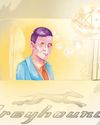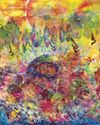
A bicycle, a cartoon character, and beer: this could only be Belgium. And so it is. We are in the land of champion cyclist Eddie Merckx, of Hergé’s Adventures of Tintin, and of twenty-one different types of beer in every bar. To complete the picture, all my photograph needs is an elegant Brussels eurocrat holding a box of Belgian chocolates in one hand and a René Magritte painting in the other, a Hercule Poirot story poking out of her Delvaux handbag. But these are stereotypes. Belgian culture is much richer and more varied than this. Even if we add singer Jacques Brel, photographer Martine Franck, and musical instrument inventor Adolphe Sax, we are still no closer to capturing Belgian-ness.
My photograph doesn’t do full justice to the subject of Belgium either: it is merely a partial depiction. In his famous painting The Treachery of Images (1929), the surrealist artist Magritte featured a tobacco pipe. Below it, he painted the paradoxical statement ‘Ceci n’est pas une pipe’ (‘This is not a pipe’). In one sense, he is correct. What we see is a two-dimensional depiction of a pipe, not an actual 3D pipe with a particular heft and warmth in the hand, an individual aroma, and a unique history. So too with my photograph. It’s a snapshot of Belgium – a vain attempt to sum up a whole country in a single two-dimensional image. As Magritte might have said, ‘Ceci n’est pas la Belgique’.
هذه القصة مأخوذة من طبعة June/July 2021 من Philosophy Now.
ابدأ النسخة التجريبية المجانية من Magzter GOLD لمدة 7 أيام للوصول إلى آلاف القصص المتميزة المنسقة وأكثر من 9,000 مجلة وصحيفة.
بالفعل مشترك ? تسجيل الدخول
هذه القصة مأخوذة من طبعة June/July 2021 من Philosophy Now.
ابدأ النسخة التجريبية المجانية من Magzter GOLD لمدة 7 أيام للوصول إلى آلاف القصص المتميزة المنسقة وأكثر من 9,000 مجلة وصحيفة.
بالفعل مشترك? تسجيل الدخول

Metaphors & Creativity
Ignacio Gonzalez-Martinez has a flash of inspiration about the role metaphors play in creative thought.

Medieval Islam & the Nature of God
Musa Mumtaz meditates on two maverick medieval Muslim metaphysicians.

Robert Stern
talks with AmirAli Maleki about philosophy in general, and Kant and Hegel in particular.

Volney (1757-1820)
John P. Irish travels the path of a revolutionary mind.

IT'S A WONDERFUL LIFE
Becky Lee Meadows considers questions of guilt, innocence, and despair in this classic Christmas movie.

"I refute it thus"
Raymond Tallis kicks immaterialism into touch.

Cave Girl Principles
Larry Chan takes us back to the dawn of thought.

A God of Limited Power
Philip Goff grasps hold of the problem of evil and comes up with a novel solution.

A Critique of Pure Atheism
Andrew Likoudis questions the basis of some popular atheist arguments.

Exploring Atheism
Amrit Pathak gives us a run-down of the foundations of modern atheism.